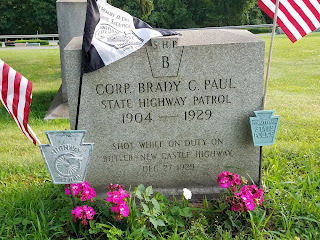This summer, I’ve
been driving to our local cemetery several mornings a week to walk in the early
hours before the heat grows too intense. These walks, surrounded by quiet,
provide abundant inspiration for many aspects of my writing. If I need a name
for a character, all I have to do is look around. No one here minds if I name a
murderer after them. (I do mix and match first and last names for the sake of
living family members who may not like seeing Uncle Joe as a serial killer.)
The names aren’t
all I pick up during my cemetery walks. Simply pausing to read the inscriptions
provides ample story ideas—such as one family stone with “Mother” engraved over
the woman’s birth and death dates. Clearly, the other side originally was
reserved for “Father,” who hadn’t passed away yet, but at some point, a small
plaque was mounted over his side with “Mother” on it again. Did the father
remarry and abandon his deceased wife for another burial plot? Did he do
something so egregious that his surviving children wanted his name wiped from
the family monument? The possibilities—and story ideas—are endless.
Sometimes, it’s
not the engraving that raises questions, but the items left at the gravesite. A
child’s stone decorated with angels and Teddy bears. A plot where stalks of
corn grow instead of flowers. Obviously, a farmer who loved his cornfield. Or
something else?
I’ve been
noodling with the idea of posting a photograph of one of these interesting
tombstones once a month as a writing prompt. I snapped a picture of one of the monuments
that has long stirred my curiosity and respect. A young Pennsylvania State
Trooper who had been killed in the line of duty at only twenty-five. Definitely
a story there.
The very next
day, this appeared in our local newspaper.
Apparently, I was
right. Two days after Christmas, in 1929, twenty-five-year-old Trooper Corporal
Brady Paul and his partner stopped a car driven by Walter Dague who, along with
his girlfriend, Irene Schroeder, had just robbed a grocery store. The pair, who
had been on a multi-state crime spree since August, gunned down both troopers.
Corporal Paul’s partner, Patrolman Ernest Moore survived his injuries. The
young corporal, however, did not.
The
Bonnie-and-Clyde-like couple ran, only to be captured nineteen days later in
Arizona.
The story and the
photos fascinated me. But they also ruined my plan to use the tombstone as a
story prompt. For one thing, I’ve come to feel like I know Corporal Paul and
don’t want to use his death as a mere idea for a fictional story. For another,
how could I come up with a better story than the real one?
I’ll file this
newspaper article and the photo of his grave marker away. Maybe someday, I will
decide on a plot—not based on his life and death but inspired by it.
So, dear fellow
writers, do you ever use real cases as inspiration for your fiction? And
readers, does it ever bother you when you read a book or watch a TV show that’s
obviously based on true crime? Does it feel like the writer has capitalized on
someone else’s pain?




I have a random file of story ideas, but they're not based on the pain of the victim's family. What makes me crazy is newly-published books appropriating a plot from a TV show broadcast two years earlier.
ReplyDeleteLike Margaret, I keep a file of story ideas - several actually, but more for contextual inspiration.
ReplyDeleteI like to wander old cemeteries, read the tombstones, and let them tell the stories of the people lying at rest. The Key West Cemetery is especially good for that. Where else can you find a tombstone that reads, I told you I was sick.
Annette, I could see you appropriately using Cpl. Paul's scenario in a Zoe/Pete book as a way to honor his sacrifice.
Agreed, Margaret.
ReplyDeleteThanks, Kait. And I love the tombstones that tell a story, even if it's a reprimand from beyond the grave!
Annette, Very thought provoking....Thanks for the perspective! I believe you have to go where the inspiration leads you, but, as you say, one must be sensitive with names changes and such (I sound like Ms. Manners). In that vein, I love your cemetery walks. My aunt went to Metamora, Illinois, for a visit to our family graves and came back with all sorts of bits of history, which were written on the stones. Guess they did that back then. ...One other thing before I go...I was in Vietnam in February, and, interestingly, saw enormous family tombs set up in the middle of rice paddies, usually isolated, standing alone and testament to the work of farming.
ReplyDeleteNancy, I think the storytelling tombstones might be making a comeback of sorts. This cemetery has monuments from the early 1800s to contemporary, and I've noticed how, in the last decade or so, the markers have become more personalized again. Not necessarily with witty quotes but with pictures. Pets engraved on the stones, photos embedded in them, etc. A neighbor and friend of ours, who was a farmer with a passion for tractors, has a lovely black granite tombstone etched with rolling farmland, and a color photo of a John Deere beneath his name.
ReplyDeleteFascinating. How could that be a coincidence?
ReplyDeleteMy daughter and her husband, both trained as archeologists, love taking rubbings of old tombstones. The live across the road from a large cemetery. And they have specific instructions in their will for the monument they want on their grave. The rest of the family is opting for cremation. And the rest of their money will go to animal rescue.
KM, you point out another side-effect of walking in the cemetery: pondering our own mortality and how we want to be remembered. A topic for another blog, perhaps.
ReplyDelete